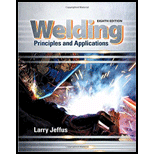
Bundle: Welding: Principles and Applications, 8th + MindTap Welding, 4 terms (24 months) Printed Access Card
8th Edition
ISBN: 9781337219426
Author: Larry Jeffus
Publisher: Cengage Learning
expand_more
expand_more
format_list_bulleted
Textbook Question
Chapter 19, Problem 7R
What would be the maximum acceptable depth of undercut on a 1/4-in. (6-mm)-thick metal plate welded in a tee joint?
Expert Solution & Answer
Want to see the full answer?
Check out a sample textbook solution
Students have asked these similar questions
+1.
0,63 fin
r= 0.051
P
The stepped rod in sketch is subjected to a tensile
force that varies between 4000 and 7000 lb. The
rod has a machined surface finish everywhere except
the shoulder area,
where a grinding operation has
been performed to improve the fatigue resistance
of the rod. Using a 99% probability of survival,
determine the safety factor for infinite life if
the rod is made of AISI 1080 steel, quenched
and tempered at 800°c Use the Goodman line.
Does the part fail at the fillet? Explain
Solve this problem and show all of the work
Solve this problem and show all of the work
Chapter 19 Solutions
Bundle: Welding: Principles and Applications, 8th + MindTap Welding, 4 terms (24 months) Printed Access Card
Ch. 19 - The AWS SENSE Level 1 Workmanship Qualifications...Ch. 19 - What skills are needed to successfully complete...Ch. 19 - What type of inspection must the welds pass?Ch. 19 - List three items that can be checked during a...Ch. 19 - What is the maximum acceptable size of the face...Ch. 19 - What is the maximum weld size for lap and tee...Ch. 19 - What would be the maximum acceptable depth of...Ch. 19 - What is the maximum acceptable root face concavity...Ch. 19 - Describe how to perform a free bend test to help...Ch. 19 - What part of a weld is the free bend designed to...
Ch. 19 - How can the 1-in. (25-mm)-wide strips be cut out...Ch. 19 - What is the range of diameters of the filler metal...Ch. 19 - What welding current is used on the carbon steel...Ch. 19 - What are the F-number and A-numbers for the...Ch. 19 - Why are solvents or detergents needed?Ch. 19 - Why might it be necessary to reclean the part...Ch. 19 - What welding current is needed for the GTA welding...Ch. 19 - Why is a lace bead more easily controlled than a...Ch. 19 - What advantage is there in making a small root...Ch. 19 - Why should the filler passes on a single-V butt...
Knowledge Booster
Learn more about
Need a deep-dive on the concept behind this application? Look no further. Learn more about this topic, mechanical-engineering and related others by exploring similar questions and additional content below.Similar questions
- Qu. 17 Compute linear density values for [100] for silver (Ag). Express your answer in nm''. . Round off the answer to three significant figures. Qu. 18 Compute linear density value for [111] direction for silver (Ag). Express your answer in nm'. Round off the answer to three significant figures. Qu. 19 Compute planar density value for (100) plane for chromium (Cr). Express your answer in nm?. Round off the answer to two significant figures. Qu. 20 Compute planar density value for (110) plane for chromium (Cr). Express your answer in nm ≥ to four significant figures. show all work please in material engineeringarrow_forward3-142arrow_forwardI need solutionsarrow_forward
- 3-137arrow_forwardLarge wind turbines with a power capacity of 8 MW and blade span diameters of over 160 m areavailable for electric power generation. Consider a wind turbine with a blade span diameter of 120m installed at a site subjected to steady winds at 8.25 m/s. Taking the overall efficiency of thewind turbine to be 33 percent and the air density to be 1.25 kg/m3, determine the electric powergenerated by this wind turbine. Also, assuming steady winds of 8.25 m/s during a 24-h period,determine the amount of electric energy and the revenue generated per day for a unit price of$0.08/kWh for electricity.arrow_forwardThe basic barometer can be used to measure the height of a building. If the barometric readingsat the top and at the bottom of a building are 672 and 696 mmHg, respectively, determine theheight of the building. Take the densities of air and mercury to be 1.18 kg/m3 and 13,600 kg/m3,respectivelyarrow_forward
- A 7.25-hp (shaft) pump is used to raise water to an elevation of 17 m. If the mechanical efficiencyof the pump is 84 percent, determine the maximum volume flow rate of water.arrow_forwardConsider a double-fluid manometer attached to an air pipe shown below. If the specific gravity ofone fluid is 13.8, determine the specific gravity of the other fluid for the indicated absolutepressure of air. Take the atmospheric pressure to be 95 kPaarrow_forwardA race car enters the circular portion of a track that has a radius of 65 m. Disregard the 70 m in the picture. When the car enters the curve at point P, it is traveling with a speed of 120 km/h that is increasing at 5 m/s^2 . Three seconds later, determine the x and y components of velocity and acceleration of the car. I'm having trouble getting the correct y component of acceleration. all the other answers are correct. thank you!arrow_forward
arrow_back_ios
SEE MORE QUESTIONS
arrow_forward_ios
Recommended textbooks for you
 Welding: Principles and Applications (MindTap Cou...Mechanical EngineeringISBN:9781305494695Author:Larry JeffusPublisher:Cengage Learning
Welding: Principles and Applications (MindTap Cou...Mechanical EngineeringISBN:9781305494695Author:Larry JeffusPublisher:Cengage Learning Refrigeration and Air Conditioning Technology (Mi...Mechanical EngineeringISBN:9781305578296Author:John Tomczyk, Eugene Silberstein, Bill Whitman, Bill JohnsonPublisher:Cengage Learning
Refrigeration and Air Conditioning Technology (Mi...Mechanical EngineeringISBN:9781305578296Author:John Tomczyk, Eugene Silberstein, Bill Whitman, Bill JohnsonPublisher:Cengage Learning

Welding: Principles and Applications (MindTap Cou...
Mechanical Engineering
ISBN:9781305494695
Author:Larry Jeffus
Publisher:Cengage Learning

Refrigeration and Air Conditioning Technology (Mi...
Mechanical Engineering
ISBN:9781305578296
Author:John Tomczyk, Eugene Silberstein, Bill Whitman, Bill Johnson
Publisher:Cengage Learning
Differences between Temporary Joining and Permanent Joining.; Author: Academic Gain Tutorials;https://www.youtube.com/watch?v=PTr8QZhgXyg;License: Standard Youtube License